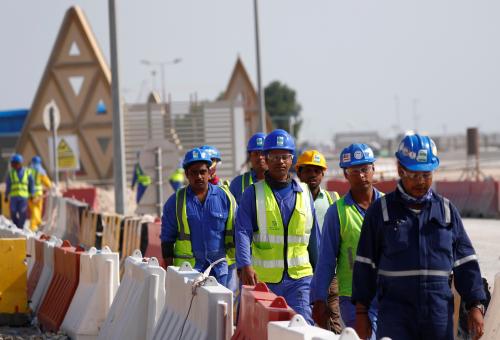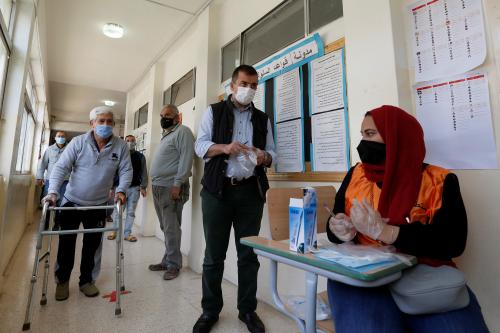Content from the Brookings Doha Center is now archived. In September 2021, after 14 years of impactful partnership, Brookings and the Brookings Doha Center announced that they were ending their affiliation. The Brookings Doha Center is now the Middle East Council on Global Affairs, a separate public policy institution based in Qatar.
In the heady days of (relatively) peaceful mass mobilizations that brought down dictators in Tunisia and Egypt, the mantra from American observers in 2011 was: “Now comes the hard part.” In 2012, it came — with a vengeance.
But my guess is that many of those watching the Arab Spring unfold did not really believe this year would be as bloody or fraught with risk as it has turned out to be. Transitions to democracy in Eastern Europe after 1989 were pretty quick and pretty successful. Latin American and East Asian transitions in the 1980s and 1990s had long and troubled backgrounds, but once democratic systems were established, most of them turned out to be stable and peaceful. Why should the Arab world be different?
Well, there are two big reasons. Unlike in those other parts of the world, many of the countries in the Middle East lack long histories of political unity: Libya, Lebanon, Syria, Jordan, Iraq, Saudi Arabia, and Yemen are all relatively recent creations; their borders are artificial and their populations are divided along sectarian, ethnic, and regional lines.
Furthermore, there is no consensus on core political issues in the Arab world. In Eastern Europe following the Cold War, as Francis Fukuyama famously pointed out, there was no serious alternative political ideology to democratic capitalism. Not so in the Middle East. A majority, or at least a plurality, of people in these countries now say “Islam is the solution” to their problems — and they are opposed by an equally vehement minority. This year has shown just how potent a recipe for conflict this mix of ideological conflict and divided societies can be.
Without further ado, here is a look at the pitfalls that dashed the rosiest prognostications about the Arab Spring in 2012 — and still loom large in 2013.
Weak States and Divided Societies
Some Arab countries have always suffered from weak governments. They’ve gotten there in different ways: Yemen has been hindered by a lack of resources, the Lebanese state has been kept weak by elites’ agreement and then civil war, and Muammar al-Qaddafi’s Libya was the victim of a bizarre political experiment in direct governance. But however it occurs, the consequences of state weakness — the strengthening of tribalism, sectarianism, and other sub-state identities and the erosion of the rule of law — are largely similar.
The Syrian state is now suffering the same fate, eaten away by civil war, defections, and economic weakness. None of this is altogether unfamiliar; the country used to be the poster child for Arab political instability. Between 1949 and 1970, it experienced nine military coups and a brief period of amalgamation with Egypt. But upon taking power, Hafez al-Assad enforced a grim, but in many quarters welcome, stability. He maintained his rule through unvarnished realpolitik, notably building bridges with the Sunni business class and brutally crushing a Muslim Brotherhood uprising in the early 1980s. The state was inefficient and corrupt, but it provided a measure of order, and Syria ceased being a playing field in which outside powers meddled and became an international player in its own right.
The nearly two years of fighting seem to have reversed whatever gains in state building that Hafez al-Assad had achieved. Public services have either collapsed or are stretched to the breaking point. Law and order has broken down. Syrians look to their own sectarian communities for safety, not the state — if they are not fleeing the country.
The problem, of course, is not particular to Syria. Tribal, regional, and sectarian factionalism make political progress in Yemen agonizingly slow, as do tribal and regional divides in Libya. Bahrain’s rulers exploit the fears of their co-religionists, the Sunni minority, toward the Shia majority to divide the opposition and solidify their control.
These sub-state identities in weak states create a vicious circle. New governments, even those freely elected, find their ability to govern severely limited. They do not have functioning bureaucracies to implement policies. Libya has struggled to rebuild police and military forces in the face of militias that are, in many cases, better armed, better funded, and better organized than the state’s forces. In Yemen, the army itself has split along factional lines.
With centralized state authority weakened, these countries have become the playing fields of regional rivalry. Local actors invite the foreigners in, looking to them for money, guns and political support. Turkey, Saudi Arabia, Iran, and Qatar are all playing in Syria and Iraq. Saudi Arabia and Iran both support factions in Lebanon. The Saudis are still the monopoly players in Yemen and Bahrain, though they warn darkly of Iranian meddling in both countries. Needless to say, such proxy wars are Kryptonite for the authority of the central state.
The Islamist Spring
Egypt and Tunisia do not suffer from weak states and divided societies, and thus still have the best chance of all the Arab Spring countries to forge stable democracies. This year’s developments, nonetheless, threw a wrench in both countries’ plans, as the heady unity of opposition to the old regime gave way to bruising battles over the country’s future. Those battles have mostly been political, electoral, and rhetorical — though there have been troubling episodes of violence in both countries. The ideological battle lines in these states are exceptionally stark: The core question for both is what role Islam will play in the new order — and so far the Islamists are winning.
In both Egypt and Tunisia, the process of writing a new constitution has polarized society. Strong electoral showings have given Islamist parties the upper hand in the constitution-writing process. More secular forces — some liberal, some perfectly comfortable with the old autocratic orders — are actively opposing them, but do not seem able to rally enough support in society to block the Islamist constitutional projects.
The turmoil is only getting worse. Cairo, Alexandria, and other Egyptian cities witnessed violent confrontations between supporters and opponents of President Mohamed Morsy in the run-up to the referendum. In Tunisia, meanwhile, Salafists have engaged in a number of acts of violence against their domestic opponents.
This isn’t a debate about the constitutions themselves, precisely. In neither case are the actual documents all that radical — neither state is about to become Iran or Saudi Arabia. Both constitutions provide for democratic systems, religious freedom, and personal liberty, albeit with a greater if somewhat undefined role for Islam and its institutions. Perhaps the most important difference between them is that the proposed Egyptian constitution preserves a strong presidency, while the Tunisian proposal calls for a parliamentary system. Rather, this is a test of strength for Islamists — ascendant after winning elections in 2011 and 2012 — and their more secular opponents.
While the Islamist-secular divide in Egypt captures more attention in the United States, the more important drama for the future of democracy in the region may be playing out in Tunisia. The most significant criticism of the Tunisian draft constitutional has come from the Salafi movement, which wants a more explicitly Islamist order. The al-Nahda party, which has Muslim Brotherhood roots and won a plurality in the 2011 elections to the constituent assembly, has soft-pedaled Islamist themes in an effort to gain secularist buy-in. But unlike the Salafis in Egypt, Tunisia’s hard-line Islamists continue to reject democratic politics — they have pressed their case through street protests and violence, including the September 2012 attack on the U.S. Embassy and an American school in Tunis. If the Tunisian Salafists can scuttle the constitutional experiment in Tunisia, the prospects for a stable democracy look bleak.
The role of Salafis, following an ultra-orthodox version of Islam, will enormously influence the future of political transitions across the Arab world. Historically, they have rejected democratic politics as a Western innovation that contradicts their belief that God, not man, is the lawgiver. They do well in elections when they run, as in Egypt and Kuwait. Their influence is magnified in civil wars, where they are disproportionately likely to join the fight, as in Syria and Iraq. But the Arab Spring has witnessed a split in the movement, with some Salafis ready to participate in electoral politics and others continuing to reject it. While we in the West worry about whether secularists can influence the course of political transitions in the Arab world, the more important question might be whether the Salafis can ever be brought on board for a democratic future.
American Policy
Let’s be honest with ourselves: If the keys to stability and democratic development in the Arab world are related to state building and an ideological argument within Islamist movements, then there is not much that the United States can do to help these processes along. Washington demonstrated in Iraq that it is more skillful at destroying states than at building them. Even if we wanted to, our overstretched military and depleted resources means that U.S. priorities must lie elsewhere for now. The United States has even less to contribute to the intra-Islamist debate among Brotherhood and Salafi trends on the appropriateness of democracy.
Nowhere is America’s inability to decisively affect the direction of internal political developments in the Arab world more evident than Syria. We have no history of close engagement with either the Syrian military or Syrian society. The most aggressive interventionists want a no-fly zone and greater American support for opposition forces, including the direct supply of weapons. But would a no-fly zone — which would quickly turn into direct engagements with Syrian forces — provide the United States with any more influence over post-Assad Syria than it has in post-Qaddafi Libya? It is doubtful. And if we were to take on the task of arming the rebels, could we confidently tell “good secularists” from “bad jihadis”? I see no reason for confidence there, as those receiving arms have an enormous incentive to mask their real preferences from possible patrons.
The best the United States can do is to allow the Arab Spring play out on its own terms. While the convulsions in the Middle East certainly affect U.S. interests, they have yet to directly damage our key strategic concern — the free flow of oil — or our relationship with Israel. Weak and failing states, to be sure, are a serious counterterrorism concern, and al Qaeda and its affiliates are sure to try to take an advantage of civil strife to revive their dying brand (see: Benghazi). But these radicals are not about to seize control of any states, and the new governments in the Arab world will certainly see jihadists as a threat once they get back on their feet.
The Arab Spring may not have yet fulfilled the expectations embodied in those early, buoyant demonstrations in Tahrir Square — but nor has it evolved into a real threat to the United States. We have good relations with the most powerful military player in the area, Israel; with the richest Arab state, Saudi Arabia; and with Turkey, a country that has managed to be both Islamist and democratic and is playing an ever-larger role in the region. With America’s strategic position still strong and our ability to affect the direction of domestic politics in the Arab world extremely limited, the Obama administration is best advised to continue to keep its hands off this troubled part of the world.



Commentary
Op-edThe Year the Arab Spring Went Bad
December 31, 2012